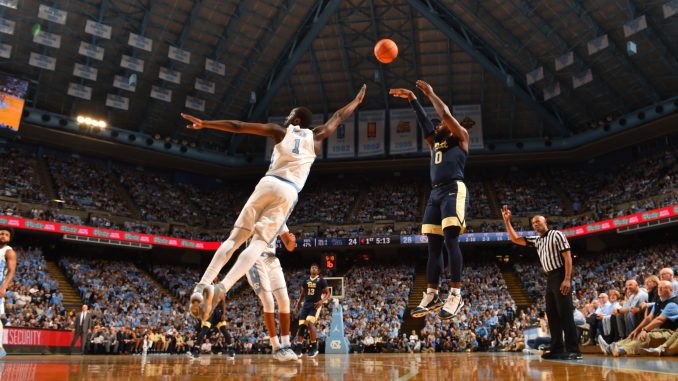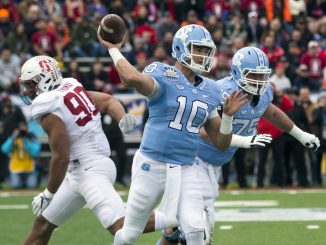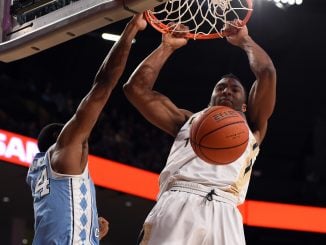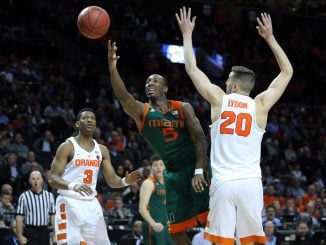
CHAPEL HILL — Much has been made of North Carolina’s struggles to defend the 3-pointer this season.
The Tar Heels have given up 276 threes. That’s already 10th-most in ACC history, with a month to go before the start of the NCAA Tournament.
While raw totals of threes allowed may not be the best measure of a team’s perimeter defense, the other stats aren’t any better. Carolina is giving up 10.22 threes per game, which would break the all-time ACC record by more than half a three per contest. Opponents are hitting at a .384 percentage, which would be Carolina’s worst season in 26 years.
“I have no answers, guys,” coach Roy Williams said after Clemson hit 15 of 30 treys to upset Carolina. “I’ve never emphasized something as much in my entire life, but you’ve got to congratulate them. They stepped up and made it.”
Clearly, the Tar Heels’ defense could be better, but a closer look reveals that there may be more to the numbers than just sheer futility.
Yes, the 276 threes allowed are the 10th-most in ACC history, but eight of the nine teams ahead of Carolina are previous UNC teams. It includes two national champions — 2017 UNC allowed 319, and the 2005 team allowed 299. It includes two teams coached by Dean Smith and one coached by Bill Guthridge.
Also, the threes-per-game record UNC is threatening was set by Smith’s 1996 Heels, with his 1995 Final Four team in second place.
The issue appears to be more complicated than just bad defense at the 3-point line. Instead, it’s a matter of how — or who — Carolina defends.
Williams’ comment about having to congratulate the other team smacks of Smith, who frequently said, “Sometimes you’ve just got to shake the other guy’s hand,” after an opponent had a particularly good day against the Heels. He said it after Fred Vinson hit 8 of 12 from three in 1994.
Williams also said something similar in 2012, when Florida State’s Deividas Dulkys hit 8 of 10. “It was a great performance shooting the basketball,” he said.
Both games have something in common: Vinson was an outside threat on a star-laden Tech team that included ACC Tournament MVP James Forrest, Travis Best and Drew Berry. Dulkys was FSU’s seventh scoring option.
In each case, as in many games this season, Carolina focuses on shutting down the biggest threats on an opponent, preferring to let a lesser talent beat them.
In the two games against NC State, for instance, Allerik Freeman and Torin Dorn combined to hit 14 of 19 threes. The four Wolfpack players likely identified as bigger threats from outside — Braxton Beverly, Markell Johnson, Omer Yurtseven and Sam Hunt — shot 8 of 21.
“I think we closed on better to take away some of the threes, which is what we wanted to do,” Williams said after the second game with the Pack, “I think Braxton had three threes in the first half and didn’t get any in the second half. I think we did a better job trying to run him off.”
Against Notre Dame, outside threats T.J. Gibbs, Matt Farrell, Rex Pflueger and D.J. Harvey shot 8 of 33, 140 percentage points lower than in all other games this season. Meanwhile, John Mooney and Nikola Djoko hit 11 of 16 from three, 327 percentage points higher.
Similarly, Duke’s Gary Trent Jr. shot just 2 of 5 against the Heels, 55 points lower than in other games, and the nation’s leading 3-point shooter, Wofford’s Fletcher Magee, shot 4 of 12, 134 points lower.
Williams admitted that Magee was a focus of the Carolina defense in that game. “He was 0 for 3 or 0 for 4, I think, at the half,” he said. “I said, ‘Guys, he’s the leading 3-point shooter in the nation. He had made 90 threes coming into the game, shooting 57.8 percent. He’s gonna come after you.’ And he did. But those were good shots for him. Kenny (Williams) I think, did a nice job on him.”
Looking at the nine games against NC State, Notre Dame, Duke, Virginia Tech, Clemson and Wofford, the main outside threats for each team shot .356 from three against the Tar Heels, compared to .403 in all other games. The afterthoughts on those teams shot .506 from three, compared to .360 in all other games.
Clearly, the UNC defense as a whole needs to tighten up, but just as clearly, the Tar Heels are capable of stopping the 3-pointer. As has been the case since the days of Dean Smith, however, it’s just a question of whose 3-pointers they choose to stop.



